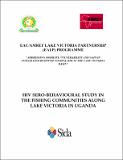| dc.description.abstract | The survey fieldwork was conducted in forty six fishing communities of the Lake Victoria
Basin of Uganda in August 2010. The main aim was to establish HIV prevalence among
fishing communities, the associated drivers of risk and vulnerability; and the effectiveness
of HIV and AIDS response.
The survey methods consisted of individual interviews, focus group discussions and key
informants interviews. A desk-review was conducted to document HIV service availability
and utilization, as well as institutional policies and structures for the coordination and
delivery of HIV services. Laboratory testing for HIV was conducted both in the field and at
central level.
A total of 911 women and men aged 15-59 years were randomly selected and interviewed
by four fieldwork teams. Of the 911 respondents, 559 (61 percent) are men and 352 (39
percent) are women. Each fieldwork survey team consisted of 4 interviewers, 1 counselor,
1 laboratory technician and 1 supervisor. Before the main survey, a pretest was carried
out. All respondents provided written consent before the interviews and blood draw. The
survey protocol was approved by the Science and Ethics Committee of the Uganda Virus
Research Institute; and cleared by the Uganda National Council for Science and
Technology. Data was captured using EPIINFO following a double data entry strategy.
Main findings
HIV prevalence and risk factors for HIV infection: Twenty two percent of the surveyed
fishing community members are infected with HIV; HIV prevalence among women is
higher (25.1 percent) than among men (20.5 percent).HIV prevalence is highest among
widows/widowers (40 percent) followed by that among divorced people (32 percent).
Furthermore, HIV prevalence is highest among respondents who had their first sex before
the age of 15 years; where it is 36 percent in women, 21 percent in men and 30 percent in
both women and men. HIV prevalence is higher among those respondents who engaged
in higher risk sex compared to those who did not do so. Additionally HIV prevalence is
higher among respondents who reported three or more lifetime sexual partners, compared
to those who reported one or two lifetime sexual partners.
Overall, HIV prevalence is higher among uncircumcised men and respondents with STI
than in circumcised men and respondents without STI, respectively. HIV prevalence is 11
percent in circumcised men and 27 percent in uncircumcised men. Furthermore, among
men with STI, HIV prevalence is 10 percent in circumcised men and 34 percent in
uncircumcised men. Among men without STI, HIV prevalence is 12 percent in circumcised
men and 25 percent in uncircumcised men.
Source of HIV information: Radio is the commonest source of HIV/AIDS information and
education. Of all information acquired on HIV prevention methods, limiting sex to one
partner is perceived as the most important information acquired from the radios. | en_US |

